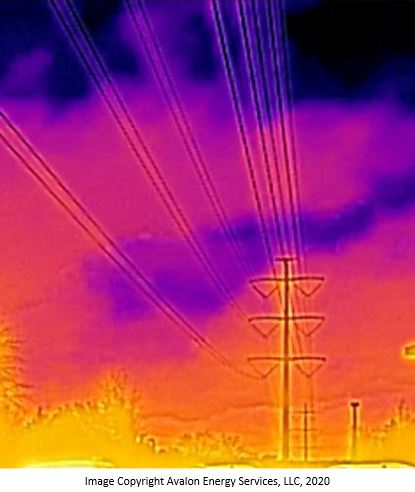Electricity and Rock: Still Not Friends
By Evelyn Teel

In a previous blog post, we discussed findings from the U.S. Geological Survey (USGS) that the I-95 corridor is particularly at risk of grid outages in the event of a geomagnetic storm. You can read that blog post here: https://avalonenergy.us/2018/07/electricity-meet-rock/.
Further research has been conducted, and a new report from the USGS was released earlier this year. You can read the full report here: https://doi.org/10.1029/2019SW002329.
The research is based on measurements from geomagnetic observatories and magnetotelluric survey sites throughout the United States, and models the impact of a once-per-century geomagnetic superstorm. Based on more than three decades of field data, the researchers modeled the voltages that could be generated within US high-power transmission lines in the event of a superstorm.
In addition to the previously identified risks along the East Coast, the report identified three additional areas of high risk: the Pacific Northwest; the Upper Midwest; and the Denver, Colorado area. The analysis only covered two-thirds of the continental United States, so unidentified areas of high risk may still exist in the South and Southwest of the country.
The two images below, from the report, illustrate modeled voltages and electric fields throughout the US transmission grid. Lighter colors indicate higher risk.
Areas of high risk are largely attributable to the geological structures of those areas, for example the crystalline rocks of the Superior Craton in the Upper Midwest and the crystalline rocks of the Piedmont Province in the Eastern US, which trends northeast-southwest from Maine to Georgia between the Appalachian Mountains and the Atlantic Coastal Plain. These electrically resistive rocks (i.e., rocks that impede the flow of electricity) in the upper mantle generate a higher geoelectric hazard. Simply put, if the generated electricity would not be absorbed into the ground, it could cause extensive damage as it remains on the surface. The interaction of the geologic structure with the geoelectric fields and the transmission line geometry results in higher storm-induced voltages on the power grid along with a higher probability of more extensive grid damage.
Geomagnetic storms and their effects do not come without warning. The National Oceanic and Atmospheric Administration (NOAA) Space Weather Prediction Center (SWPC) reports on global magnetic deviations throughout the day, using a measure called the K-index. Working with data collection centers around the world, SWPC consolidates readings into a global Kp index every three hours. SWPC is also able to issue alerts when values surpass specific thresholds, which serves as a warning system for potential geomagnetic issues. More information about the K-index can be found here: https://www.swpc.noaa.gov/sites/default/files/images/u2/TheK-index.pdf and current and historical planetary K-indices can be found here: https://www.swpc.noaa.gov/products/planetary-k-index.
Further research is ongoing, and there is certainly more to learn about this natural hazard. Ideally the data will be used by utility companies to evaluate the risks within their own geographies, identify potential solutions, and even possibly use this information to inform future transmission grid construction. Though not covered in the report, geomagnetic storms also can impact distribution lines, electricity generation facilities, and related equipment; the entities that oversee these components of the electric system should also evaluate their risks and take action where possible. Canada and Finland have taken technological steps to reduce the impact of geomagnetic storms, such as through transformer design (https://fas.org/irp/agency/dod/jason/spaceweather.pdf), that can inform approaches within the United States.
On an individual basis, as we noted previously, there are not many options for mitigating this hazard. Some facilities may choose onsite or distributed generation as a mitigation (you can learn more about distributed energy resources here: https://avalonenergy.us/2020/04/distributed-energy-resources-give-you-options/); however, depending on the types of distributed energy resources used and the strength and geographic impact of the geomagnetic storm, distributed resources may also be susceptible to failure. Faraday cages can block electromagnetic fields, though they also can block helpful signals like radio waves, cell phone signals, and wi-fi.
Our modern reliance on electronics makes us particularly susceptible to geomagnetic storms at this point in history. Previous storms have knocked out communication channels and caused blackouts, though the largest known storms occurred before the huge explosion in electronics we have seen in the past few decades. The Carrington Event in 1859 was the largest recorded geomagnetic storm, while a much smaller 1989 storm caused a blackout in Quebec, Canada. You can learn about these events and more on NASA’s website: https://science.nasa.gov/science-news/science-at-nasa/2008/06may_carringtonflare.
We will continue to keep an eye on this developing research, and will share any additional findings as they are published. In the meantime, we count ourselves lucky to live in a time when the scientific community understands this issue, is doing the research necessary to gauge the impact, and may find ways to mitigate the effects.
Thank you to Jeff Dowdell and Ralph Russell for their contributions to this article.
The Avalon Advantage – Visit our website at www.avalonenergy.us, call us at 888-484-8096, or email us at info@avalonenergy.us.
Please feel free to share this article. If you do, please email or post the web link. Unauthorized copying, retransmission, or republication is prohibited.
All images copyright 2020 Avalon Energy® Services LLC, unless otherwise noted.
Copyright 2020 by Avalon Energy® Services LLC
